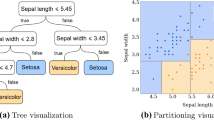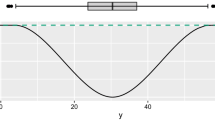Abstract
The present paper deals with supervised classification methods based on Galois lattices and decision trees. Such ordered structures require attributes discretization and it is known that, for decision trees, local discretization improves the classification performance compared with global discretization. While most literature on discretization for Galois lattices relies on global discretization, the presented work introduces a new local discretization algorithm for Galois lattices which hinges on a property of some specific lattices that we introduce as dichotomic lattices. Their properties, co-atomicity and \(\vee \)-complementarity are proved along with their links with decision trees. Finally, some quantitative and qualitative evaluations of the local discretization are proposed.






Similar content being viewed by others
Notes
Galois lattices defined from a closed/finite data set.
The convergence property relies on the complete definition of objects, i.e. if knowledge on objects increases the concepts just become more precise and are not modified.
Considering that the number of concepts in a lattice can be exponential in the number of objects and attributes, note that concepts can be generated on demand during the navigation process, see Visani et al. (2011).
Noisy data contain useless and cumbersome information, as an example the image artefact representation in signatures extracted from images forms a noise.
Binary table reduction deletes the attributes satisfied by all objects, and the objects satisfying all attributes.
An inseparable problem occurs when objects belonging to different classes have the same description.
For comparison with other decision trees refer to Visani et al. (2011), where experiments have shown that Galois lattice obtains better recognition rates than decision trees in a context of noisy data.
References
Barbut M, Monjardet B (1970) Ordres et classifications : algèbre et combinatoire, 2 tomes. Hachette, Paris
Bertet K, Visani M, Girard N (2009) Treillis dichotomiques et arbres de décision. Traitement Signal 26(5):407–416
Birkhoff G (1940) Lattice theory, 1st edn. American Mathematical Society, New York
Birkhoff G (1967) Lattice theory, vol 25, 3rd edn. American Mathematical Society, New York
Bordat JP (1986) Calcul pratique du treillis de Galois d’une correspondance. Math Sci Hum 96:31–47
Breiman L, Friedman J, Olshen R, Stone C (1984) Classification and regression trees. Wadsworth Inc., Belmont
Caspard N, Leclerc B, Monjardet B (2012) Finite ordered sets: concepts, results and uses. In: Collection encyclopedia of mathematics and its applications, vol 144, Cambridge University Press, Cambridge
Coustaty M, Bertet K, Visani M, Ogier JM (2011) A new adaptive structural signature for symbol recognition by using a Galois lattice as a classifier. IEEE Trans Syst Man Cybern Part B Cybern 41(4):1136–1148
Davey B, Priestley H (1991) Introduction to lattices and orders, 2nd edn. Cambridge University Press, Cambridge
Diday E, Emilion R (2003) Maximal and stochastic Galois lattices. Discrete Appl Math 127(2):271–284 (ordinal and symbolic data analysis (OSDA ’98), University of Massachusetts, Amherst, 28–30 September 1998)
Dougherty J, Kohavi R, Sahami M (1995) Supervised and unsupervised discretization of continuous features. In: Machine learning. Proceedings of the 12th international conference, Morgan Kaufmann, pp 194–202
Esposito F, Malerba D, Semeraro G (1997) A comparative analysis of methods for pruning decision trees. IEEE Trans Pattern Anal Mach Intell 19:476–491
Fayyad U, Irani K (1993) Multi-interval discretization of continuous-valued attributes for classification learning. In: Proceedings of the international joint conference on uncertainty in AI, Morgan Kaufman, pp 1022–1027
Frank E, Witten I (1999) Making better use of global discretization. In: Proceedings of 16th international conference on machine learning, Bled, pp 115–123
Fu H, Fu H, Njiwoua P, Mephu-Nguifo EM (2004) A comparative study of FCA-based supervised classification algorithms. In: Concept lattices. LNCS, vol 2961. Springer, Berlin, pp 219–220
Ganter B (1984) Two basic algorithms in concept analysis. In: Technische Hochschule Darmstadt (preprint 831)
Ganter B, Kuznetsov S (2001) Pattern structures and their projections. In: Delugach H, Stumme G (eds) Conceptual structures: broadening the base. LNCS, vol 2120. Springer, Berlin, pp 129–142
Ganter B, Wille R (1989) Conceptual scaling. In: Roberts F (ed) Applications of combinatorics and graph theory to biological and social sciences. LNCS. Springer, Berlin, pp 139–167
Ganter B, Wille R (1999) Formal concept analysis. In: Mathematical foundations. Springer, Berlin
Godin R, Missaoui R, April A (1998) Experimental comparison of navigation in a Galois lattice with conventional information retrieval methods. Int J Man Mach Stud 38:747–767
GREC (2003) Images base GREC 2003 (Graphics RECognition). http://www.cvc.uab.es/grec2003/symreccontest/index.htm. Accessed 08 January 2008
Guillas S, Bertet K, Visani M, Ogier JM, Girard N (2008) Some links between decision tree and dichotomic lattice. In: Proceedings CW (ed) Proceedings of the sixth international conference on concept lattices and their applications, CLA 2008, pp 193–205
Hotelling H (1936) Relations between two sets of variates. Biometrika XXVII I (2):321–377
Hwang G, Li F (2002) A dynamic method for discretization of continuous attributes. In: Yin H, Allinson N, Freeman R, Keane J, Hubbard S (eds) Intelligent data engineering and automated learning. LNCS, vol 2412. Springer, Berlin, pp 181–193
Kass GV (1980) An exploratory technique for investigating large quantities of categorical data. J R Stat Soc Ser C (Appl Stat) 29(2):119–127
Kaytoue M, Kuznetsov SO, Napoli A, Duplessis S (2011) Mining gene expression data with pattern structures in formal concept analysis. Inf Sci 181(10):1989–2001
Klimushkin M, Obiedkov S, Roth C (2010) Approaches to the selection of relevant concepts in the case of noisy data. In: Kwuida L, Sertkaya B (eds) Proceedings of the 8th international conference formal concept analysis. LNCS/LNAI, vol 5986. Springer, New York, pp 255–266
Kuznetsov S (2007) On stability of a formal concept. Ann Math Artif Intell 49:101–115
Kuznetsov S, Obiedkov S (2001) Algorithms for the construction of concept lattices and their diagram graphs. In: De Raedt L, Siebes A (eds) Principles of data mining and knowledge discovery. LNCS, vol 2168. Springer, Berlin, pp 289–300
Kuznetsov S, Obiedkov S, Roth C (2007) Reducing the representation complexity of lattice-based taxonomies. In: Priss U, Polovina S, Hill R (eds) Proceedings of the ICCS 15th international conference on conceptual structures. LNCS/LNAI, vol 4604. Springer, New York, pp 241–254
Lichman M (2013) UCI machine learning repository. University of California, Irvine, School of Information and Computer Sciences. http://archive.ics.uci.edu/ml
Liquière M, Mephu-Nguifo E (1990) LEGAL: LEarning with GAlois Lattice. Actes des Journées Françaises sur l’Apprentissage (JFA). Lannion, France, pp 93–113
Liu H, Hussain F, Tan CL, Dash M (2002) Discretization: an enabling technique. Data Min Knowl Discov 6:393–423
Mingers J (1989) An empirical comparison of pruning methods for decision tree induction. Mach Learn 4:227–243
Morgan JN, Sonquist JA (1963) Problems in the analysis of survey data, and a proposal. J Am Stat Assoc 58(302):415–434
Muhlenbach F, Rakotomalala R (2002) Multivariate supervised discretization, a neighborhood graph approach. In: Proceedings of 2002 IEEE International conference on data mining, 2002. ICDM 2003, pp 314–321. doi:10.1109/ICDM.2002.1183918
Muhlenbach F, Rakotomalala R (2005) Discretization of continuous attributes. In: Idea Group Reference (ed) Encyclopedia of data warehousing and mining, John Wang, pp 397–402
Oosthuizen GD (1988) The use of a lattice in knowledge processing. PhD thesis, University of Strathclyde, Glasgow
Öre O (1944) Galois connexions. Trans Am Math Soc 55(3):493–513
Quinlan JR (1979) Discovering rules by induction from large collections of examples. In: Michie D (ed) Expert systems in the micro-electronic age. Edinburgh University Press, Edinburgh, pp 168–201
Quinlan JR (1986) Induction of decision trees. Mach Learn 1(1):81–106. doi:10.1023/A:1022643204877
Quinlan JR (1987) Generating production rules from decision trees. Proceedings of the 10th international joint conference on artificial intelligence -, vol 1. Morgan Kaufmann, San Francisco, pp 304–307
Quinlan JR (1993) C4.5: programs for machine learning. Morgan Kaufman, Los Altos
Quinlan JR (1996) Improved use of continuous attributes in C4.5. J Artif Intell Res 4:77–90
Rokach L, Maimon O (2005) Decision trees. Data mining and knowledge discovery handbook. Springer, New York, pp 165–192
Roth C, Obiedkov SA, Kourie DG (2006) Towards concise representation for taxonomies of epistemic communities. In: CLA, pp 240–255
Sahami M (1995) Learning classification rules using lattices. In: Lavrac N, Wrobel S (eds) Proceedings of the European conference on machine learning, ECML’95, Heraclion, Crete, pp 343–346
Stumme G (1996) Local scaling in conceptual data systems. In: ICCS’96, pp 308–320
van der Merwe D, Obiedkov S, Kourie D (2004) Addintent: a new incremental algorithm for constructing concept lattices. In: Eklund P (ed) Concept lattices. LNCS, vol 2961. Springer, Berlin, pp 372–385
Visani M, Bertet K, Ogier JM (2011) Navigala: an original symbol classifier based on navigation through a Galois lattice. Int J Pattern Recognit Artif Intell 25(4):449–473
Wille R (1982) Restructuring lattice theory: an approach based on hierarchies of concepts. In: Ordered sets, pp 445–470
Zhang XH, Wu J, Lu TJ, Jiang Y (2007) A discretization algorithm based on Gini criterion. In: International conference on machine learning and cybernetics, vol 5, pp 2557–2561
Zighed D, Rakotomalala R, Feschet F (1997) Optimal multiple intervals discretization of continuous attributes for supervised learning. In: Heckerman D, Mannila H, Pregibon D, Uthurusamy R (eds) Proceedings of the third international conference on knowledge discovery and data mining. AAAI Press, pp 295–298
Author information
Authors and Affiliations
Corresponding author
Rights and permissions
About this article
Cite this article
Girard, N., Bertet, K. & Visani, M. Dichotomic lattices and local discretization for Galois lattices. Adv Data Anal Classif 11, 49–77 (2017). https://doi.org/10.1007/s11634-015-0225-7
Received:
Revised:
Accepted:
Published:
Issue Date:
DOI: https://doi.org/10.1007/s11634-015-0225-7




